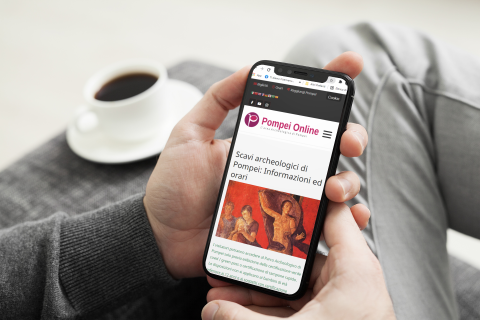THE CHARIOT
The chariot was found inside a double-level portico which probably faced onto an uncovered courtyard, not far from the already-investigated stable, to which it was connected by a door.
The layer of cinerite which entombed the chariot had allowed the preservation of its original dimensions and of the individual parts which mark out the connected structure.
The artefact in question is a four-wheeled chariot which, on the basis of information recorded by sources and the few archaeological traces that have otherwise been found to date, can probably be identified as a pilentum, a transport vehicle used in the Roman world by the elites in ceremonial contexts.
Atop high iron wheels, connected by an advanced mechanical system, rests the light carriage (0.90 x 1.40 m), or the main part of the chariot, where the seat was located, surrounded by metal arm and backrests, for either one or two individuals.
The carriage is richly decorated along both sides with alternating engraved bronze sheet and red and black painted wooden panels, whilst at the rear there is a complex and extensive decorative system featuring three distinct registers with a succession of bronze and tin medallions with figurative scenes.
These medallions, set in bronze sheet and surrounded by decorative motifs, represent male and female figures in relief, depicted in erotic scenes. The bronze sheet is also decorated in its upper section with small medallions, also in tin, which depict cupids engaged in various activities. In the lower section of the chariot there is a small female herm in bronze with a crown.
Archaeobotanical analyses were also conducted in this instance, which showed that the wood used to create the side structures and rear of the chariot, to which the bronze decorative elements were fixed with small nails and clamps, was beech, which is particularly suitable for this kind of production.
This kind of chariot is entirely unique in Italy, not only on account of its state of preservation, as we have not only individual decorations but the entire vehicle, but also because it is not a chariot used for the transport of agricultural products or the activities of daily life, as is already attested both at Pompeii and Stabiae.
We might recall that in the adjacent stable, which had already been investigated, it was possible to create casts not only of the trough, but also of a large horse, which bore a rich bronze harness.
In the same room two other horses were discovered, one lying on its right side and the other on its left, of which it was sadly not possible to make a cast as a result of the damage caused by the tunnels of the grave robbers, and subsequent overbuilding of the cavities, which destroyed the context of the discovery. Nevertheless, other bronze harness elements were recovered, relating to a saddle and other parade elements, which can certainly be connected to the newly discovered chariot.
HE FOUR-WHEELED PROCESSIONAL CHARIOT. THE LATEST DISCOVERY OF POMPEII
Page 4 of 5
- Details
- Written by: Comunicato stampa


